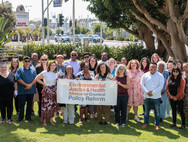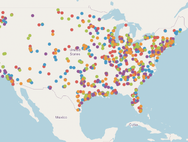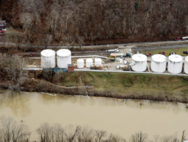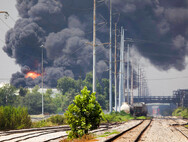
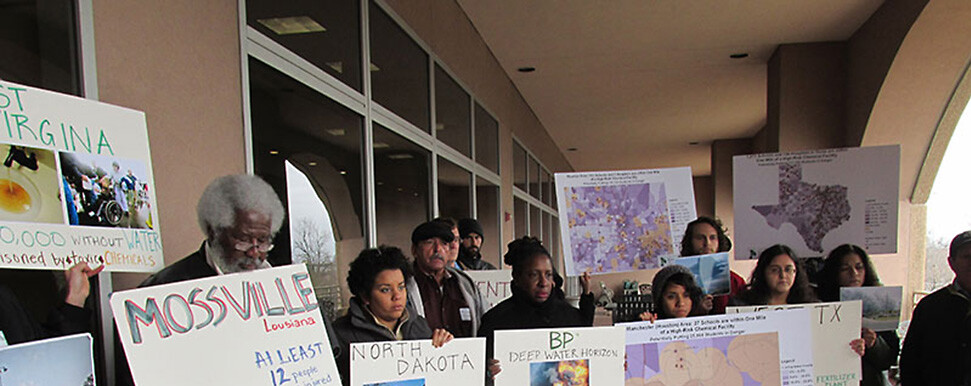
Media
Media
Share this page:
News Archive
Year
Community, Health, and Environmental Groups Sue to Stop President Trump’s Unlawful Toxic Air Pollution Exemptions
October 22, 2025
WASHINGTON, D.C. – Community, health, and environmental groups sued the Trump administration today to stop an executive action that would unlawfully exempt 50 of the country’s most toxic chemical manufacturing plants from protections that guard people against dangerous cancer-causing air pollutants, including ethylene oxide and chloroprene. “We’ve fought for decades to close loopholes and get real checks on chemical leaks. These standards target the dangerous chemicals that create a huge cancer risk in communities like Mossville, Louisiana, and others throughout the country,” said Michele Roberts, national coordinator of the Environmental Justice Health Alliance for Chemical Policy Reform (EJHA). “Delaying them is a policy choice with a human cost, measured in diagnoses, not dollars. The Clean Air Act doesn’t allow a president to waive our human right to health or hand polluters a free pass without evidence.”
Read More
We're hiring an EJHA Administrative Associate
October 14, 2025
Coming Clean is seeking part-time, short-term administrative support for the Environmental Justice Health Alliance for Chemical Policy Reform (EJHA). The EJHA Administrative Associate will report to, and take direction from the EJHA National Organizer.
Read MoreTrump Is Using the Shutdown to Supercharge His War on Equity
October 9, 2025
As the federal government shutdown stretches into its second week, President Donald Trump is targeting nearly $30 billion in cuts to federal funding almost exclusively to Democratic states and cities. The impact of the cuts to public transit, energy projects, and fundamental civil rights programs could carry far-reaching harms across the nation and the economy. The cuts are the next step in the implementation of executive orders issued by Trump that strive to eradicate policies that advance racial and gender equity, tackle the climate crisis, and threaten the fossil fuel industry. "When the Biden-Harris administration came in, they did not just create plans in a vacuum, they went and listened to people in the community” to learn what projects were needed, “and financing flowed from those discussions,” Michele Roberts of the Environmental Justice Health Alliance. The programs included projects to address historic and ongoing environmental racism and injustices, and the disproportionate health and economic burdens in Black and Brown communities that followed.
100 Orgs & Individuals with Environmental Justice Networks Say to EPA: Revoking Endangerment Finding Puts All Our Communities in Danger
September 30, 2025
NATIONWIDE – In response to the Environmental Protection Agency (EPA) seeking to remove the Endangerment Finding and revoke vehicle emissions regulations, a coalition of environmental justice networks submitted written comments – signed by 100 organizations and individuals – alongside a powerful collection of testimonies that capture the real-world impacts of climate and transportation pollution and frontline and fenceline communities’ need for robust protections. The coalition of environmental justice groups warn that EPA’s decision undermines their mission and puts millions of lives at risk, placing environmental justice communities in the greatest danger. They also share a clear set of demands: The EPA must stop its proposal to revoke the Endangerment Finding and Greenhouse Gas Vehicle Standards, renew its commitment to environmental justice, restore essential funding, and commit to regulations that protect current and future generations.
Read MoreChemical Incident Tracker updated after EPA deletes data
September 18, 2025
The Coalition to Prevent Chemical Disasters published updates to its open-access chemical disaster tracking tool today that allow users to see how close they live to highly hazardous facilities covered by the U.S. Environmental Protection Agency’s (EPA) Risk Management Program (RMP). The Chemical Incident Tracker continues to allow users to search for chemical releases, fires and explosions that have been reported in the media since January 2021, using an interactive map. The tracker is updated with new incidents weekly.
Read MorePolluter free passes show Trump Administration’s indifference to community health
September 9, 2025
Exposure to chemical plant pollution can shorten lives and contribute to many health problems. Last year, the U.S. Environmental Protection Agency (EPA) finally took action to reduce emissions of cancer-causing toxics like ethylene oxide and chloroprene from chemical plants, and developmentally-toxic mercury and heavy metals from coal plants. President Trump’s proclamations give over 150 facilities (52 chemical plants, 39 sterilizers and 68 of the country’s dirtiest coal plants) a free pass to ignore these pollution-reducing rules that would otherwise protect lives and health.
Read MoreEnvironmental Groups Sue EPA Demanding Protections from Hazardous Chemicals
August 28, 2025
A coalition led by environmental justice organizations filed a suit against the U.S. Environmental Protection Agency today for refusing to issue long-overdue rules to prevent hazardous-substance discharges that threaten public health and contaminate waterways. Across the United States, more than 100,000 facilities make, store, or use hundreds of hazardous chemicals linked to reproductive, developmental, and neurological harm – including benzene, hydrogen sulfide, sulfuric acid, hydrogen cyanide, and hydrochloric acid. “For generations environmental justice communities have lived next to some of the most hazardous facilities in the country that threaten the bodies of water our families rely on to survive. Now more than ever we must prioritize creating safe and healthy places where all of our children can thrive and grow.” said Michele Roberts, National Coordinator of the Environmental Justice Health Alliance for Chemical Policy Reform. “The EPA’s do-nothing approach leaves us one incident away from a catastrophe.”
Read More
Trump gives Louisville plant more time to address pollution. Homes sit 500 feet away
August 5, 2025
Bakelite Synthetics, the only major source of formaldehyde emissions in Jefferson County, will have more time to comply with Biden-era pollution control requirements following a Trump proclamation. The plant neighbors the Riverside Gardens community, where residents have raised concerns about chemical emissions and other hazards in the past. "This would be the perfect time for this city to strengthen that permit in an effort to reduce our exposure to any of the chemicals coming from Bakelite," Eboni Cochran, a longtime environmental justice advocate with Rubbertown Emergency ACTion, or REACT, said in a text message. "There are solutions," Cochran said. "The city just needs to have enough will and courage to protect its residents."
Read MoreYear-long study reveals toxic chemicals in popular dollar store products
May 8, 2025
A new year-long study from the Campaign for Healthier Solutions (CHS) claims that many popular products found at the biggest dollar store chains across the country contain toxic chemicals. The report showed that nearly 50 personal care, baby, beauty, and cleaning products were found to have toxic chemicals. Many of these products were kids’ toys or baby products, which raises concerns for parents – especially parents of young kids, who often put things in their mouths."Busy parents shouldn't have to scan the ingredients list of every product they buy to make sure it's safe for our families,” Yolanda Brown Alston, director of workforce programs at Harambee House, said in a news release. “Dollar stores need to step up on chemical safety and provide quality products that add value to our communities.”
Read MoreLas pruebas impulsadas por la comunidad nuevamente revelan sustancias químicas preocupantes en los productos de las tiendas del dólar
May 7, 2025
La Campaña para Soluciones más Saludables / Campaign for Healthier Solutions (CHS, por sus siglas en inglés) publicó hoy los resultados del esfuerzo de todo un año para recopilar, analizar y examinar los productos de las tiendas del dólar en busca de sustancias químicas preocupantes. Los productos preocupantes resaltados que se compraron en Dollar Tree/Family Dollar y/o Dollar General incluyen: Loción para bebé “Baby Shark” que contiene un químico liberador de formaldehído; crema hidratante diaria que contiene un producto químico prohibido en los cosméticos europeos; pulseras con iluminación, rosas de plástico y mini cubetas de dulces contenían plomo; los productos infantiles hechos de cloruro de polivinilo o PVC y los recibos de compra de ambas tiendas del dólar contenían bisfenol-S.
Read MoreCommunity-driven testing again reveals chemicals of concern in dollar store products
May 7, 2025
The Campaign for Healthier Solutions (CHS) today published the results of a year-long effort to collect, test, and screen dollar store products for chemicals of concern. Highlighted products of concern purchased at Dollar Tree/Family Dollar and/or Dollar General include: “Baby Shark” baby lotion containing a formaldehyde-releasing chemical; daily moisturizer containing a chemical banned in European cosmetics; light-up children’s bracelets, plastic roses and mini candy pails containing lead; children’s products made with polyvinyl chloride or PVC, and receipts containing bisphenol-S. Published the week of Mother’s Day, “Product Testing for the People: Pitfalls, Persistence, and Progress in Transforming Dollar Stores” provides safe shopping tips for families and actionable recommendations for Dollar Tree and Dollar General to expand, improve, and enforce their chemical policies. The report also highlights loopholes in federal law that allow companies to sell products containing chemicals of concern, showing the importance of corporate action. Take action!
Read MoreTrump Administration’s Decision to Rehash Chemical Disaster Prevention Rules Will Endanger Millions of Workers and Fenceline Community Residents
March 11, 2025
The U.S. Environmental Protection Agency (EPA) announced Thursday that it plans to rehash regulations under the Risk Management Program (RMP). The decision comes after lobbyists for the chemical industry sent a letter requesting the agency weaken the rule requiring nearly 12,000 highly hazardous industrial facilities to prevent and plan for chemical disasters.
The EPA is bending to the will of corporate lobbyists who are seeking to eliminate stronger rules finalized in 2024. These more protective rules were the result of years of public debate and incorporated input from industry and the public alike, including advocacy by environmental justice, labor, occupational and public health, and environmental organizations.
Read MoreTrump administration considers rolling back chemical plant safeguards
March 7, 2025
“It would mean a real disservice to communities, first responders and workers,” said Adam Kron, an attorney with Earthjustice. “It would put them in greater harm’s way from these chemical disasters.” Earthjustice is part of a coalition of environmental groups that tracks chemical disasters. This coalition has found that since January 2021, there have been more than 1,100 chemical incidents. The news of a potential rewrite comes days after Trump’s address to a joint session of Congress, in which he vowed to take on toxic chemicals, saying, “our goal is to get toxins out of our environment, poisons out of our food supply and keep our children healthy and strong.” Yet that rhetoric also comes as Trump has pledged broad deregulatory action, which could clash with upholding chemical safeguards.
Read MoreSustainable Chemistry Cannot Deliver Environmental Justice Unless Fenceline Communities are Protected
March 5, 2025
So-called sustainable and/or green chemistry is being promoted in many circles as a means to both harness chemistry innovation to support more sustainable economies and reduce the environmental and public health impacts of chemical manufacturing. As we work to build research and policy which deliver health protections and justice to communities most impacted by the toxic harm of the chemical industry, we must critically examine sustainable chemistry initiatives and ask who will benefit from the technologies and practices. When something is promoted as “sustainable chemistry,” who is it sustainable for? Read more of this joint blog from Coming Clean and EJHA.
Read MoreKentucky Bill Would Limit Use of Community Science
February 19, 2025
Rubbertown Emergency ACTion's Eboni Cochran speaks out against attempts to limit community science for health protection in this Kentucky Lantern story.
Read MoreMedia Share this page: |
What Is Environmental Justice? | Campaign for Healthier Solutions | Campaign for Healthier Solutions |
THE ENVIRONMENTAL JUSTICE HEALTH ALLIANCE IS IN STRATEGIC PARTNERSHIP WITH COMING CLEAN
info@comingcleaninc.org • (802) 251-0203 • EJHA – Coming Clean, 28 Vernon Street, Suite 434, Brattleboro, VT 05301
© 2025 Coming Clean Inc.



